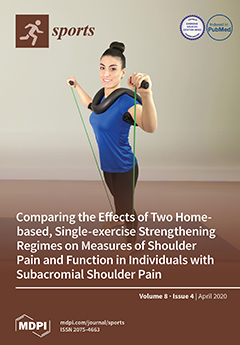Caffeine’s ergogenic effects persist during various exercise modalities; however, information establishing its efficacy during CrossFit
® protocols is limited. This study aimed to determine the effects of caffeine supplementation on CrossFit
® performance. Twenty CrossFit
®-trained men (age = 26.7 ± 6.2
[...] Read more.
Caffeine’s ergogenic effects persist during various exercise modalities; however, information establishing its efficacy during CrossFit
® protocols is limited. This study aimed to determine the effects of caffeine supplementation on CrossFit
® performance. Twenty CrossFit
®-trained men (age = 26.7 ± 6.2 years, experience = 3.7 ± 2.9 years) were randomized in a double-blind, crossover design. Participants completed two sessions separated by a seven-day washout period, 60 min after consuming 5 mg/kg body mass of caffeine or a placebo. In each session, participants completed as many rounds as possible in 20 min of five pull-ups, 10 push-ups, and 15 air squats. CrossFit
® performance was the total number of repetitions completed in 20 min. Paired-samples t-tests were used to compare CrossFit
® performance between caffeine and placebo conditions and to test for a potential learning effect between the first and second sessions. CrossFit
® performance was not significantly different during the caffeine condition compared to the placebo (468.6 ± 114.7 vs. 466.7 ± 94.3 repetitions,
p = 0.861). A significant learning effect was identified between the first and second sessions (452.4 ± 101 vs. 483.8 ± 106.5 repetitions,
p = 0.001), with no significant effect of treatment order (
p = 0.438). Caffeine’s ergogenic effect were not present during the CrossFit
® workout “Cindy”; however, future research should include familiarization sessions and examine other CrossFit
® workouts in novice and women participants.
Full article






